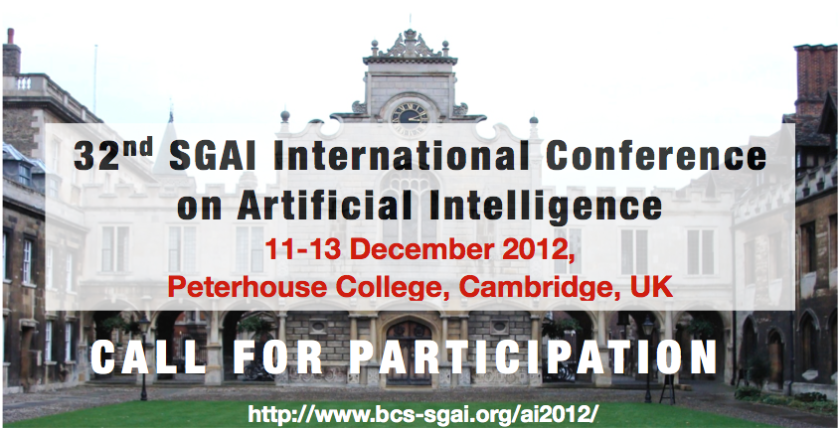 Like Lotta I met Eduardo Lupiani Ruiz at an ICCBR Doctoral Consortium where he presented his research topic. Eduardo is PhD student at the Departamento de Ingeniería de la Información y las Comunicaciones, University of Murcia, Spain. For four months he will be working with us on his research topic, temporal case selection. He is addressing the problem whether case selection techniques are valid for domains where temporal relations exist either among cases or among their features. During his stay we will look at opportunities to use and/or enhance myCBR for such kinds of domains.
Like Lotta I met Eduardo Lupiani Ruiz at an ICCBR Doctoral Consortium where he presented his research topic. Eduardo is PhD student at the Departamento de Ingeniería de la Información y las Comunicaciones, University of Murcia, Spain. For four months he will be working with us on his research topic, temporal case selection. He is addressing the problem whether case selection techniques are valid for domains where temporal relations exist either among cases or among their features. During his stay we will look at opportunities to use and/or enhance myCBR for such kinds of domains.
Kategorie: myCBR
Lotta Rintala guest of my research group
 I met Lotta Rintala already at ICCBR 2011 but we only got talking at the ICCBR 2012 Doctoral Consortium in Lyon, France, where she presented her research topic. She is looking at how to use CBR for gold ore pretreatment selection. It quickly became clear that her work could benefit from a stay with my research group at the University of West London and that we, on the other hand, could benefit from a myCBR Workbench user who is not a software engineer.
I met Lotta Rintala already at ICCBR 2011 but we only got talking at the ICCBR 2012 Doctoral Consortium in Lyon, France, where she presented her research topic. She is looking at how to use CBR for gold ore pretreatment selection. It quickly became clear that her work could benefit from a stay with my research group at the University of West London and that we, on the other hand, could benefit from a myCBR Workbench user who is not a software engineer.
Lotta is a PhD student at the School of Chemical Technology at Aalto University, Finland. For four months – starting in March – Lotta will be working with us. Goal of her research visit is to study how to formally represent cases in her domain using myCBR Workbench, and how to effectively retrieve relevant cases. My team and I will assist in the respective knowledge modelling and programming tasks.
Tutorial: myCBR and Colibri Studio at AI 2012 Conference
From CBR researchers and students we learned that Colibri Studio and myCBR are perceived as competitors. But nothing is further from the truth. Colibri Sudio and myCBR complement each other. At ICCBR 2012 we gave tutorials on our open source tools (announced here) together and decided in discussions afterwards to further promote their interoperability at other venues.
 We are happy to showcase myCBR and Colibri Studio at AI 2012, the thirty-second Annual International Conference of the British Computer Society’s Specialist Group on Artificial Intelligence (SGAI), which will be held in the attractive surroundings of Peterhouse College in Cambridge. The introductory tutorial will be given as part of the main conference by Christian Sauer, University of West London, and Dr Juan Antonio Recio García, Complutense University of Madrid.
We are happy to showcase myCBR and Colibri Studio at AI 2012, the thirty-second Annual International Conference of the British Computer Society’s Specialist Group on Artificial Intelligence (SGAI), which will be held in the attractive surroundings of Peterhouse College in Cambridge. The introductory tutorial will be given as part of the main conference by Christian Sauer, University of West London, and Dr Juan Antonio Recio García, Complutense University of Madrid.
Additionally, there will be a talk about myCBR and Colibri Studio at the 17th UK Workshop on Case-Based Reasoning (UKCBR 2012).
You can register online here.
CBR is coming home: Competence Centre Case-Based Reasoning at DFKI in Kaiserslautern
I am happy and excited to report that Case-Based Reasoning research is becoming a prominent research topic in Kaiserslautern again. The German Research Center for Artificial Intelligence DFKI GmbH has founded the Competence Center CBR under the lead of Klaus-Dieter Althoff, professor at the University of Hildesheim.
CBR was an important research topic at the University of Kaiserslautern at the research group of Prof. Michael M. Richter until his retirement in 2003. At the knowledge management research department and the accompanying university research group Knowledge-based Systems of Prof. Andreas Dengel CBR was one of the research and teaching topics of Armin Stahl and me. Together we developed the CBR tool myCBR, which now becomes a focal point of further research and innovation transfer to industry.
UKCBR and AI 2008 in Cambridge
At UKCBR I presented the „Explanation Capabilities of the Open Source Case-Based Reasoning Tool myCBR“ (co-authored with my student Daniel Bahls). … The presentation „Code Tagging and Similarity-based Retrieval with myCBR“, also co-authored with Daniel, presented the coTag system. coTag is a code tagging plug-in that allows annotating code snippets in the integrated development environment eclipse.
 Already a month ago I enjoyed very much going to the 28th International Conference on Artificial Intelligence AI 2008 and the UK Case-Based Reasoning workshop UKCBR 2008. The workshop was the thirteenth of this successful series. It was the first time I went to either event and I intend to go again. That they took place in Cambridge at Peterhouse college was an added bonus. You can find some photos here.
Already a month ago I enjoyed very much going to the 28th International Conference on Artificial Intelligence AI 2008 and the UK Case-Based Reasoning workshop UKCBR 2008. The workshop was the thirteenth of this successful series. It was the first time I went to either event and I intend to go again. That they took place in Cambridge at Peterhouse college was an added bonus. You can find some photos here.
I had my hands full with four presentations over the course of the three days.
At UKCBR I presented the „Explanation Capabilities of the Open Source Case-Based Reasoning Tool myCBR“ (co-authored with my student Daniel Bahls). I am also happy that Miltos Petridis, organiser of UKCBR invited me to demonstrate the rapid prototyping capabilities of myCBR in a demonstration session.
A special highlight was the invited talk „Using Statistical Translation Models for Textual CBR“ by Luc Lamontagne from Laval University, Québec, Canada.
At AI-2008 I gave two talks, both related to my explanation research. The presentation „Code Tagging and Similarity-based Retrieval with myCBR“, also co-authored with Daniel, presented the coTag system. coTag is a code tagging plug-in that allows annotating code snippets in the integrated development environment eclipse. It offers an easy-to-use interface for tagging and searching not only for exactly the same but for similar tags. For better understanding how coTag comes up with its solution we used the above mentioned explanation capabilities of myCBR.
My second talk was based on a paper I wrote with another student, Florian Mittag: „ReduxExp: An Open-source Justification-based Explanation Support Server“. Here we worked on a mechanism for recording decisions of information systems. In the talk I described the architecture of ReduxExp and first experiences with the system.
Highlights of AI 2008 surely were the machine intelligence competition with live presentations (strictly limited to 15 minutes each) and the Gala Dinner held by candlelight (and without enough heating!) in the dining hall of Peterhouse college.
ECCBR 2008
There were also two personal highlights: I was invited to participate in a panel discussion on open source software and I had a talk together with Armin Stahl where we presented myCBR for rapid prototyping and also its explanation capabilities. … Mehmet Göker, with whom I have organised ECCBR 2006, took the view of a global player in software use whereas Eyke Hüllermeier, professor at University of Marburg, took on the role of academia.
Last week I attended the ninth European Conference on Case-Based Reasoning ECCBR 2008 in Trier, Germany. Just around the corner of Kaiserslautern, one could say.
The conference was again a great experience. The community is special. I always feel welcome and at home. From talking to other participants to this conference series I know that even people who attended the conference for the first time feel the same.
A first highlight of this year’s conference was the invited talk by Pádraig Cunningham and Barry Smyth. They analysed research themes in CBR conference literature. One motivation was to check whether our often pessimistic view of our community was founded. It was quite nice to learn that they found that the CBR community is in fact quite healthy. What a relief 🙂 Their analysis discovered a few evolving CBR themes such as recommender systems and diversity, case-base maintenance, adaptation, creativity and knowledge-intensive CBR, and conversational CBR. Their evaluation shows clear evidence of sustained innovation and maturing research. An important discovery surely is that the impact factor is comparable with big AI conferences such as ECAI and ECML.
ECCBR 2008 also presented an innovation: The Computer Cookery Contest CCC. The task:
Write your own software application for the live competition. Show that your program is more creative than the average kitchen user. Let your computer’s recipe creations be evaluated by a professional cook and an international jury of scientists! [From the call for participation]
The competition was quite entertaining. Some of the systems provided, well, interesting recipes when they needed to change ingredients in order to accommodate for ingredients at hand / in the fridge. You can find the results here.
There were also two personal highlights: I was invited to participate in a panel discussion on open source software and I had a talk together with Armin Stahl where we presented myCBR for rapid prototyping and also its explanation capabilities.
The discussion panel was chaired by Ralph Traphöner, a former colleague. Mehmet Göker, with whom I have organised ECCBR 2006, took the view of a global player in software use whereas Eyke Hüllermeier, professor at University of Marburg, took on the role of academia. They discussed with three open source software providers, i.e., with Christian Brockmann (eclipse project smila), Pedro Gonzalez Callero (jColibri), and me (myCBR).
The talk about myCBR was received very well. Over the course of the conference I was asked to show the tool to several attendees who either planned to evaluate myCBR in commercial settings or want to use it for teaching purposes. In my part of the talk I presented some of the explanation capabilities built into myCBR. Go and check out myCBR 🙂
Explanation, Dialog, and Communication: Supporting the Use of Complex Information Systems
I gave another talk on explanation, dialog, and communication, this time at the University of Hildesheim, Germany, on January 24, 2007. Klaus-Dieter Althoff invited me to discuss this topic with his work group.
I gave another talk on explanation, dialog, and communication, this time at the University of Hildesheim, Germany, on January 24, 2007. Klaus-Dieter Althoff invited me to discuss this topic with his work group.
Explanation, Dialog, and Communication: Supporting the Use of Complex Information Systems
Therefore, it becomes increasingly important for computer systems to have advanced explanation capabilities.Complex personal information systems will be part of the results of the EU project Nepomuk – The Social Semantic Desktop [1]…. But more complex lifting operations are under development, and explanation needs become obvious.Case-Based Reasoning (CBR) systems are another example of complex information systems.
Update: Handout of slides
I will give an invited talk at Università della Svizzera Italiana, Lugano, Switzerland, on January 11, 2007. (see announcement)
Abstract
Explanation, trust, and transparency are concepts that are strongly associated with information systems. One trusts a computer system much more if it can explain what it is doing and, thus, can „prove“ its trustworthiness. An information system (and more so a knowledge-based one) should be able to explain at every point in time why it prefers solution A over solution B. Furthermore, it should tell about the meaning of concepts used, and where an information item originally came from („knowledge provenance“). Explanations are part of human understanding processes and part of most dialogs, and, therefore, need to be incorporated into system interactions in order to, for example, improve decision-making processes. As information systems grow more and more complex, computer support is needed. Therefore, it becomes increasingly important for computer systems to have advanced explanation capabilities.
Complex personal information systems will be part of the results of the EU project Nepomuk – The Social Semantic Desktop [1]. Those systems will allow annotating and linking of arbitrary information objects on one‘s desktop such as documents, emails, address book entries, photos, and bookmarks. In addition, Nepomuked systems such as gnowsis automatically crawl and classify (or tag) information objects, thus linking them to one’s personal information model ontology (PIMO). (For example, address book entries become PIMO persons.) But more complex lifting operations are under development, and explanation needs become obvious.
Case-Based Reasoning (CBR) systems are another example of complex information systems. In e-commerce scenarios, the case base often is filled from product catalogs. Modeling the similarity measures for products is a complex task for the knowledge engineer, who can be supported by providing explanations about the structure and content of the case base. Such support features are currently being implemented in the open source CBR tool myCBR [2]. First results will be shown.
References
[1] http://nepomuk.semanticdesktop.org
[2] http://mycbr-project.net
